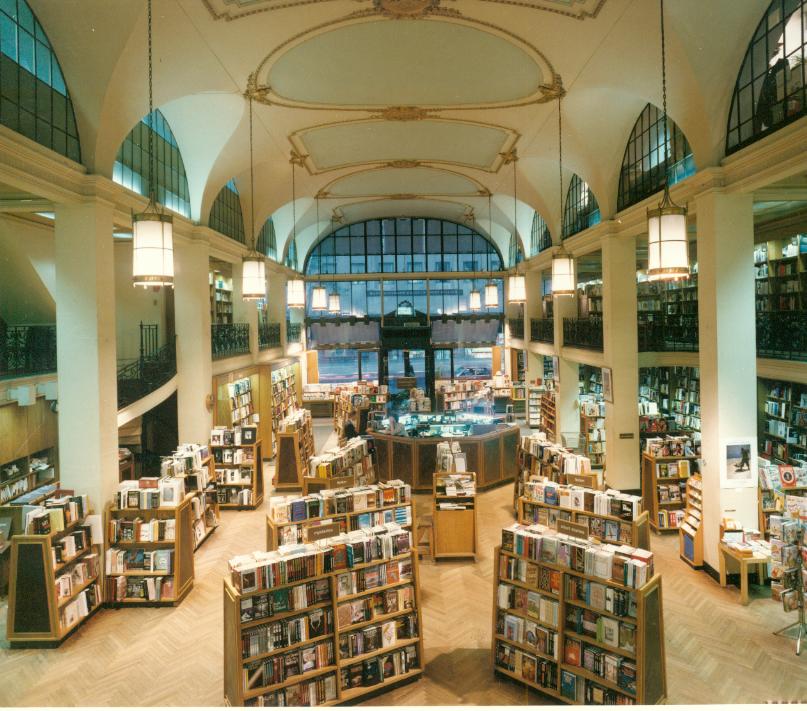While New York is a city of perpetual, dramatic change, when I first moved there around 1980 there were still buildings and venues that had lingered since the earlier part of the century and were hallowed in literature and music. One could still hear jazz at the same clubs that attracted The Beat Generation, drink coffee at the Howard Johnson's in Greenwich Village as did Jack Kerouac, and sit at a table in the Rose Room at the Algonquin Hotel that was once shared by the "Round Table" critics; the Cornelia Street Cafe was tiny and sold just coffee and some very dry pastries, and the bar stool where Dylan Thomas had his final sixteen whiskeys was still functional, even if those who sat at that bar weren't.
Not only was the Scribner Building still in place on 5th Avenue, but its sumptuous bookstore was also in service. In fact, Charles Scribner, Jr. still ran the family business. [An aside: Scribner was the senior warden of St. Bart's Church in Manhattan; when I visited there one Sunday and signed their guest book I received, later that week, a handwritten "thank you" from him. I still have it.]
This profile, originally posted on September 7th of 2012, was a remembrance of my early days in a New York that's not around anymore. I would lament its passing, as one laments the passing of youth, if I were of a sentimental and less realistic nature.
When I first moved to Manhattan at the age of 25, there were some sights that I wanted to see. Not the usual ones, like the Empire State Building or Statue of Liberty, not that there's anything wrong with viewing those, but there were places of more esoteric history that claimed my curiosity.
CBGB, The Mudd Club, and The Bitter End were among the collection, as they were places strongly identified with the music I favored at the time. Just about anything on Bleeker Street, as anyone familiar with post-war, "Beat Generation" literature could recognize locations featured in those stories. Let's see, the J.J. Hat Center, then on Herald Square, mainly because I received a catalog from them every so often. [Why? I never knew.] The original Abecrombie and Fitch, back when they sold fishing and hunting equipment rather than pan-sexual clothing of questionable taste. The offices of the Village Voice. The music stores on "guitar alley". I'm sure I could think of others if I put my mind to it.
Certainly, though, one of the sites was the Scribner bookstore and its adjacent offices on Fifth Avenue.

It became a Benetton store around the time I moved from Manhattan. I don't know what it is now, but I'm sure it sells some equally useless nonsense. In my day, it was a place that understood the spiritual and liberating nature of books; like a small temple of literacy.

But it was the offices that particularly attracted me, because once upon a time, in the glory days of American literature in the first half of the 20th century, up those narrow stairs would ascend the literary lions who shared not only the same publisher, but the same editor.
F. Scott Fitzgerald, Ernest Hemingway, Thomas Wolfe, Ring Lardner, Marjorie Kinnan Rawlings, and many others were nurtured in their art by Maxwell Perkins [pictured up top]. He was so precise and helpful that even Hemingway's notorious ego surrendered to Perkins' suggestions, including chopping away nearly one-third of The Sun Also Rises.
Just walking up those antique steps to the Scribners' offices seemed like a self-guided museum tour, leading to the same hallway where the distinctive voice of literature in the American Century was wrought. My first visit I was lost in a rapture of letters until a security guard stopped me and asked my business. When I explained why I was there he said, "Oh, you're one of those."
Of Perkins, more may be read here. There is also a very good biography, titled Max Perkins: Editor of Genius, that I would recommend to anyone who is interested in 20th century American literature and what went on behind the scenes in the vintage publishing world.
One of Perkins' letters to a young writer included this quotation, which reflects what was important in capturing the American experience in prose: "I think, in truth, that the best writing of all is done long after the events it is concerned with, when they have been digested and reflected upon unconsciously, and the writer has completely realized them in himself."
The Great Gatsby, A Farewell to Arms, Look Homeward, Angel, and The Yearling all reflect this wisdom. See how gracefully balanced is Lardner's short story "Haircut" and appreciate what a storyteller and an editor can create when working in harmony.
